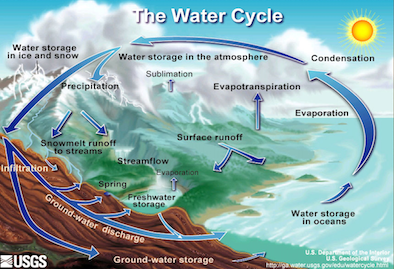The water cycle is the continuous movement of water on the Earth. There is not much change as to the amount of water on Earth, but there are many fluctuations as to where this water exists. Water can be a part of four different reservoirs: ice, fresh water, saline water, and atmospheric water. Water is able to move from one reservoir to another through either evaporation, condensation, precipitation, infiltration, run-off, or sub-surface flow. These are all illustrated in the diagram below. Throughout the water cycle, water will change between its various states of liquid, solid, and vapour many times.
Consider some water that starts as saline water in the ocean and we will be able to see an example of the water cycle in action. Due to heat from the sun, this water will evaporate into vapour. As it rises, the cooler temperatures will cause the water droplets to condense into clouds, which eventually becomes condensed enough to begin precipitating. As this precipitation lands on the mountains up high it may freeze into ice. Soon the sun warms this ice up and it melts creating runoff down into a freshwater stream. This freshwater stream can lead to a freshwater lake which will eventually begin evaporating again, completing the water cycle. This is only one iteration of the water cycle and is not the only way that water can move through this cycle.

© BrainMass Inc. brainmass.com June 30, 2024, 9:23 am ad1c9bdddf
